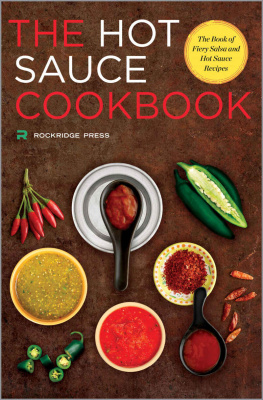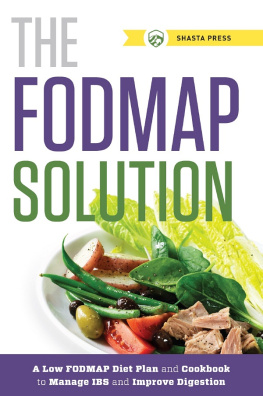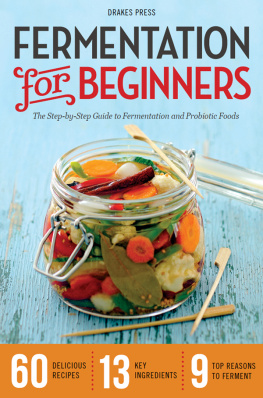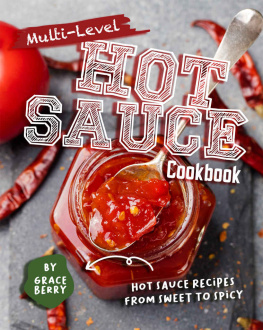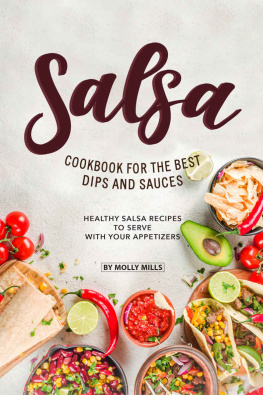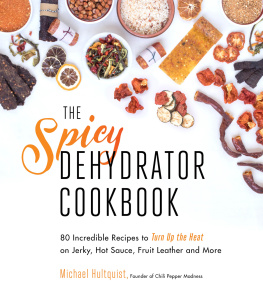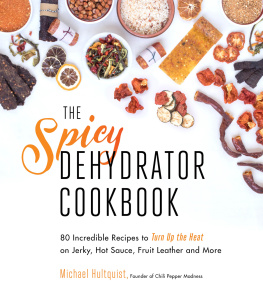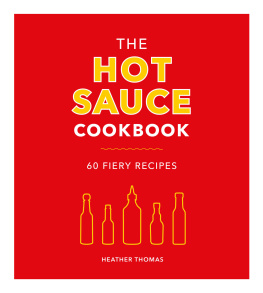Press - The hot sauce cookbook: the book of fiery salsa and hot sauce recipes
Here you can read online Press - The hot sauce cookbook: the book of fiery salsa and hot sauce recipes full text of the book (entire story) in english for free. Download pdf and epub, get meaning, cover and reviews about this ebook. City: Berkeley;California, year: 2014, publisher: Callisto Media Incorporated;Rockridge Press, genre: Home and family. Description of the work, (preface) as well as reviews are available. Best literature library LitArk.com created for fans of good reading and offers a wide selection of genres:
Romance novel
Science fiction
Adventure
Detective
Science
History
Home and family
Prose
Art
Politics
Computer
Non-fiction
Religion
Business
Children
Humor
Choose a favorite category and find really read worthwhile books. Enjoy immersion in the world of imagination, feel the emotions of the characters or learn something new for yourself, make an fascinating discovery.
- Book:The hot sauce cookbook: the book of fiery salsa and hot sauce recipes
- Author:
- Publisher:Callisto Media Incorporated;Rockridge Press
- Genre:
- Year:2014
- City:Berkeley;California
- Rating:3 / 5
- Favourites:Add to favourites
- Your mark:
- 60
- 1
- 2
- 3
- 4
- 5
The hot sauce cookbook: the book of fiery salsa and hot sauce recipes: summary, description and annotation
We offer to read an annotation, description, summary or preface (depends on what the author of the book "The hot sauce cookbook: the book of fiery salsa and hot sauce recipes" wrote himself). If you haven't found the necessary information about the book — write in the comments, we will try to find it.
Press: author's other books
Who wrote The hot sauce cookbook: the book of fiery salsa and hot sauce recipes? Find out the surname, the name of the author of the book and a list of all author's works by series.
The hot sauce cookbook: the book of fiery salsa and hot sauce recipes — read online for free the complete book (whole text) full work
Below is the text of the book, divided by pages. System saving the place of the last page read, allows you to conveniently read the book "The hot sauce cookbook: the book of fiery salsa and hot sauce recipes" online for free, without having to search again every time where you left off. Put a bookmark, and you can go to the page where you finished reading at any time.
Font size:
Interval:
Bookmark:

Copyright 2014 by Rockridge Press, Berkeley, California
No part of this publication may be reproduced, stored in a retrieval system or transmitted in any form or by any means, electronic, mechanical, photocopying, recording, scanning or otherwise, except as permitted under Sections 107 or 108 of the 1976 United States Copyright Act, without the prior written permission of the Publisher. Requests to the Publisher for permission should be addressed to the Permissions Department, Rockridge Press, 918 Parker St, Suite A-12, Berkeley, CA 94710.
Limit of Liability/Disclaimer of Warranty The Publisher and the author make no representations or warranties with respect to the accuracy or completeness of the contents of this work and specifically disclaim all warranties, including without limitation warranties of fitness for a particular purpose. No warranty may be created or extended by sales or promotional materials. The advice and strategies contained herein may not be suitable for every situation. This work is sold with the understanding that the publisher is not engaged in rendering medical, legal or other professional advice or services. If professional assistance is required, the services of a competent professional person should be sought. Neither the Publisher nor the author shall be liable for damages arising herefrom. The fact that an individual, organization or website is referred to in this work as a citation and/or potential source of further information does not mean that the author or the Publisher endorses the information the individual, organization or website may provide or recommendations they/it may make. Further, readers should be aware that Internet websites listed in this work may have changed or disappeared between when this work was written and when it is read.
For general information on our other products and services or to obtain technical support, please contact our Customer Care Department within the U.S. at (866) 744-2 6 65, or outside the U.S. at (510) 253-0500.
Rockridge Press publishes its books in a variety of electronic and print formats. Some content that appears in print may not be available in electronic books, and vice versa.
TRADEMARKS Rockridge Press and the Rockridge Press logo are trademarks or registered trademarks of Callisto Media Inc. and/or its affiliates, in the United States and other countries, and may not be used without written permission. All other trademarks are the property of their respective owners. Rockridge Press is not associated with any product or vendor mentioned in this book.
ISBN Print 978-1-62315-365-6 | eBook 978-1-62315-366-3
Photo credits: Maja Smend/Stockfood, p.ii; Andrew Scrivani/Stockfood, p.vi; HannLeonPhoto/ Thinkstock, p.2; Laurange/StockFood, p.7; Bronze Photography/Stockfood, p.8; Natasha Breen/Shutterstock, p.18; Kai Schwabe/Stockfood, p.28; Natasha Breen/Shutterstock, p.58; Joop Hoek/Shutterstock, p.84; Corey McKenna/Thinkstock, p.106; AGfoto/Shutterstock, p.128; Michael Meisen/Stockfood, p.140.


CONTENTS
INTRODUCTION
W hen it comes to chiles, the joke is on Mother Nature. These bright and attractive fruits were naturally engineered with a defense mechanism meant to cause pain and repel hungry mammals. But if their spicy hot flavor is unpleasant and irritating, why have humans sought chiles out for thousands of years? Because as soon as we feel the hot sting from a chile, our bodies release pain-killing endorphins that are stronger than morphine and just as addictive.
Hot sauce is the best way to get that chile rush. Today there are many hot sauce varieties available at most supermarkets, but it wasnt always this way. Few folks cared about chiles until the 1980s, when the popularity of Southwestern cuisine piqued interest in spicy chiles. Then in the 1990s, people discovered an array of hot sauces beyond the ubiquitous Tabasco brand. Producing and eating really hot sauce was still considered an eccentric fad, but today chile conventions, festivals, and institutes are dedicated to exploring everything about these spicy plants. Farmers, both professional and amateur, hybridize chiles to constantly produce new varieties, some specifically seeking the title of hottest chile in the world.
As noted by Dr. Paul Bosland, professor of horticulture at New Mexico State University (popularly known as the Chileman), the number of chile varieties is staggering, and there is an equally staggering amount of information about them yet to be discovered. In Austin, Texas, Dr. Jean Andrews (also known as The Pepper Lady) took interest in organizing the world of chiles and published two books on the subject: Peppers, the Domesticated Capsicums in 1984 and The Pepper Trail: History and Recipes from Around the World in 1999. Both remain the definitive sources for chile history and ethnobotany. The first chile-centric periodical, Chile Pepper magazine, was founded by Dave DeWitt and published in 1987. Since then, countless books and websites have been published and dedicated solely to chiles and hot sauces.

Public interest in chiles has been growing, but these plants have a long history in cuisine, dating back seven thousand years. There is a lot of confusion about the difference between chiles and peppersif there is any difference at all. untangles the mystery of chile nomenclature and introduces some of the most popular and recognizable hot sauces made and sold around the world today.
Depending on where you are in the country, most grocery stores carry at least a few chiles or hot sauces with familiar flavors. You can always count on fresh bell peppers, pickled jalapeos, Tabasco sauce, red pepper flakes, and ground cayenne pepper, but there are hundreds more to try. explores a small cross section of chiles and their heat levels, from warm to scorching.
covers the basic ingredients, equipment, and cooking methods needed to make a great hot sauce. Be sure to carefully read how to properly handle chiles and how to safely store the sauce once its made. Dont miss the ten tips for how to make great hot sauce.
Chapters have over seventy-five hot sauce recipes and dishes in which to enjoy them. Start with hot sauces from Central America, the Southwest, and Louisiana, and then move on to blazing hot sauces from the West Indies and the Caribbean. Try some easy Asian hot sauces, including Thai, Chinese, Korean, Indian, and Turkish recipes. Then explore hot sauces from Hawaii, South America, Spain, Mozambique, and Tunisia. And of course you can try out your own flavor combinations.
How Much Fire?
Rating the heat in a dish is tricky business. Commercially, pepper sauces are most often labeled mild, medium, and hot, three words that just barely cover the experience of the genus Capsicum. The heat in peppers varies from type to type and within each type as well. Thats part of the fun of working with hot peppers: the unknown.
The heat in any given pepper is caused by (a) its DNA and (b) its environment. Soil, water, and most importantly, sun, all affect the heat you are about to eat. The is the gold standard for assessing the heat of peppers, and even that venerable system has to give a range of heat units to compensate for all the variables.
Font size:
Interval:
Bookmark:
Similar books «The hot sauce cookbook: the book of fiery salsa and hot sauce recipes»
Look at similar books to The hot sauce cookbook: the book of fiery salsa and hot sauce recipes. We have selected literature similar in name and meaning in the hope of providing readers with more options to find new, interesting, not yet read works.
Discussion, reviews of the book The hot sauce cookbook: the book of fiery salsa and hot sauce recipes and just readers' own opinions. Leave your comments, write what you think about the work, its meaning or the main characters. Specify what exactly you liked and what you didn't like, and why you think so.

